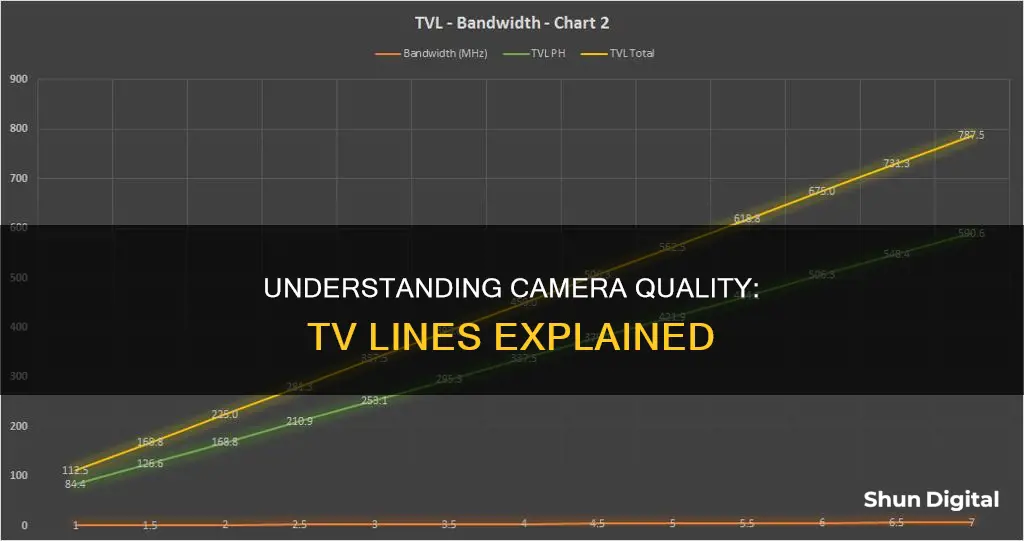
TVL, or television lines, is a measure of an image's resolution displayed by an analog monitor or recorded by an analog camera. It is one of the most important resolution measures in a video system. The TVL can be measured with the standard EIA 1956 resolution chart. The TVL of a camera is determined by factors such as the sensor type and lens quality. In security, most businesses use a higher-level TVL camera, meaning a higher recording resolution of the camera.
| Characteristics | Values |
|---|---|
| Definition | Television lines (TVL) is a specification of an analog camera or monitor's horizontal image resolution. |
| Importance | TVL is one of the most important resolution measures in a video system. |
| Calculation | TVL is defined as the maximum number of alternating light and dark vertical lines that can be resolved per picture height. |
| Measurement | TVL is frequently measured using a TVL resolution chart known as the EIA 1956 Resolution Chart. |
| Image Quality | A higher number of TVL means the camera will be able to render images with more detail and better picture quality. |
| Resolution Range | Surveillance cameras’ TVL ratings range from 380 TVL to 1200 TVL. |
| Resolution Limitations | The DVR and cable that carries an analog camera are maxed out at 720 TVL. |
| Aspect Ratio | The aspect ratio of D1 resolution is 4:3. |
| Pixels vs TVL | TVL measures a camera's ability to resolve detail in analog systems, while pixels are a unit of measurement for digital images. |
What You'll Learn
- TVL is a measure of an image's resolution
- TVL is influenced by the camera's sensor type and lens quality
- Limitations of the rest of the system can affect the resolution of the final image
- TVL is not the sole factor that determines the quality of the final output
- TVL is an analog measure, whereas 1080p is a digital measure

TVL is a measure of an image's resolution
TVL, or television lines, is a measure of an image's resolution. It is defined as the maximum number of alternating light and dark vertical lines that can be displayed per picture height. In other words, it is a measure of the resolution of an image in the vertical direction.
The TVL of an image is influenced by the visual bandwidth of the transmission system used. For example, the number of horizontal scanning lines in a system may be fixed, but the ability to display fine detail within each line can be affected by factors such as the camera or source of the material, the storage and processing of the picture, and the transmission of the TV signal.
When considering the resolution of an image, it is important to understand that TVL only measures the number of vertical lines and not the horizontal lines. This is an important distinction because the horizontal lines in a video system are typically fixed, while the vertical lines can vary depending on the camera and other factors.
In the context of CCTV cameras, TVL is often used as a selling point, with manufacturers boasting huge TVL numbers of up to 1000TVL. However, it is important to note that these numbers are often misleading. True TVL is only measured over a square equal to the height of the image, not the entire widescreen image.
Furthermore, TVL is not a measure of how much detail a camera captures. For example, a 550TVL camera may be able to read a number plate at 8 meters, while a 750 TVL camera with the same lens would not be able to capture any more detail at a greater distance. Therefore, it is important to consider other factors, such as the optical range of the camera, when evaluating its performance.
Employee Surveillance: Is It Legal?
You may want to see also

TVL is influenced by the camera's sensor type and lens quality
Television lines (TVL) refer to the horizontal image resolution of an analogue camera or monitor. It is a measure of the maximum number of alternating light and dark vertical lines that can be resolved per picture height. For example, a resolution of 400 TVL means that 200 distinct dark vertical lines and 200 distinct white vertical lines can be counted over a horizontal span equal to the height of the picture.
The number of TV lines a camera can record is determined by several factors, including the sensor type and lens quality. The camera's sensor refers to the component that captures light and converts it into a digital signal to create an image. The type of sensor used in a camera can impact its sensitivity to light, dynamic range, and overall image quality. Different types of sensors include CCD (Charge-Coupled Device) sensors and CMOS (Complementary Metal-Oxide Semiconductor) sensors, each with its own advantages and disadvantages.
Lens quality is another critical factor influencing TVL. The lens is responsible for focusing light onto the camera's sensor. A high-quality lens can capture sharper images with better contrast and colour accuracy. It can also improve the camera's low-light performance and reduce distortion. Conversely, a lower-quality lens may introduce aberrations and artefacts that degrade the image quality, reducing the effective TVL of the camera.
In addition, the resolution of an image is determined by the number of pixels it contains. Pixels are the tiny dots that make up digital images, and a higher number of pixels generally equates to a higher-resolution image. For example, a camera with a 2-megapixel image sensor has 2 million pixels.
It is worth noting that TVL is influenced not only by the camera's sensor and lens but also by other factors such as the encoding and formatting system used to transmit the image, including PAL, NTSC, or SECAM. Moreover, the weakest link in the entire CCTV system, including the camera, DVR, monitor, and cabling, can impact the overall image quality.
Camera Jitter: Can It Cause Poor TV Resolution?
You may want to see also

Limitations of the rest of the system can affect the resolution of the final image
The limitations of the rest of a camera system can indeed affect the resolution of the final image. This is because the resolution of the entire CCTV system, or system TVL, is dictated by the weakest link in the chain. In other words, it's the sum of all the factors that affect image quality, including the camera, DVR, monitor, and security camera cabling.
For example, a camera with a 1200 TVL resolution will only produce images with that level of detail if it's recorded by a DVR with the same or better resolution. If the DVR only has a 700 TVL resolution, the images from the security cameras will only be displayed with 700 TVL of detail, regardless of the camera's resolution.
Analog DVRs have a maximum resolution of 720 TVL, so a camera with a higher resolution, such as 1000 TVL or 1200 TVL, will only be able to display at 720 TVL when used with an analog DVR. To take full advantage of a higher-resolution camera, such as a 1200 TVL camera, you would need to use an HDCVI, AHD, or IP system, which can support up to 1080p (2-megapixel) resolution.
The encoding and formatting system used to transmit the image will also affect the TVL. For example, the PAL (Phase Alternating Line) and NTSC (National Television Standards Committee) systems employ 625 and 525 lines, respectively, which can impact the resolution of the final image.
It's also important to note that the TVL of a camera is influenced by the visual bandwidth of the transmission system used. The camera's sensor type and lens quality are also factors that determine the number of TV lines a camera can record.
When considering a security camera system, it's crucial to understand the difference between system TVL and camera TVL to ensure that the final image resolution meets the desired requirements.
Vizio TV Chromecast: Camera Included or Not?
You may want to see also

TVL is not the sole factor that determines the quality of the final output
Television lines (TVL) refer to the horizontal image resolution of an analog camera or monitor. TVL is defined as the maximum number of alternating light and dark vertical lines that can be resolved per picture height. While TVL is an important resolution measure in a video system, it is not the only factor that determines image quality.
The quality of the final output is influenced by a range of factors beyond TVL. Firstly, the camera itself plays a role. The optical range of the camera, for example, is crucial in capturing detail. A higher TVL does not necessarily equate to capturing more detail; a camera with a suitable optical range for the specific application is more important.
The storage and processing of the image can also impact the final output. The DVR and cable used with an analog camera, for instance, have a maximum resolution of 720TVL, so a camera advertised as 1000TVL will not produce a better recording. The DVR and camera must be appropriately paired to ensure the DVR can take full advantage of the camera's resolution.
The transmission of the TV signal can also impede the display of fine detail. This includes the method of transmission, such as radio or cable, and the receiving equipment, such as a TV set.
Additionally, the field of view (FOV) of a camera-lens system is another factor that influences image quality. The FOV is the angular range of the observable area, which can be measured using tools like the Imatest Concentric Rings FOV Module. This takes into account factors such as the working distance, ring radius, and field angle to determine the observable area of the camera-lens system.
In summary, while TVL is an important specification for analog cameras and monitors, it is not the sole determinant of image quality. A range of other factors, from the camera and DVR specifications to the transmission method and field of view, collectively contribute to the final output's quality.
Intoxalock's Cameras: Are They Really Watching You?
You may want to see also

TVL is an analog measure, whereas 1080p is a digital measure
Television lines (TVL) are a measure of an image's resolution displayed by an analog monitor or recorded by an analog camera. TVL is defined as the maximum number of alternating light and dark vertical lines that can be resolved per picture height. It is an inherent quality of a camera or monitor, influenced by the visual bandwidth of the transmission system used.
TVL is one of the most important resolution measures in a video system. It is frequently measured using a TVL resolution chart known as the EIA 1956 Resolution Chart. This chart has a series of black-and-white lines that gradually get closer together. The number of TVL is equal to the number of lines on the chart that are still clear and distinct.
On the other hand, 1080p is a digital measure of resolution. It refers to the number of pixels in an image, specifically 1920 x 1080 pixels. Pixels are the tiny dots that make up digital images. For example, a camera with a pixel count of 2 megapixels (MP) would have 2 million pixels. Therefore, the resolution of an image is determined by the number of pixels it contains.
Comparing TVL and 1080p, it is important to note that they are different measures of image resolution. TVL is an analog measure, while 1080p is a digital measure. In terms of image quality, 1080p offers a much higher resolution than TVL. For example, 1080p has about 400% higher resolution than a 700 TVL analog camera.
In addition, digital cameras offer superior image quality compared to analog cameras. They can transmit digital data over long distances without losing quality, as the data is sent in a compressed digital form. Analog cameras, on the other hand, transmit an analog signal that is susceptible to interference and degradation over long distances, resulting in a loss of image quality.
Therefore, it is important to understand the difference between TVL and 1080p when considering the resolution and image quality of a camera or monitor.
Becoming a TV Camera Person: Skills and Steps
You may want to see also
Frequently asked questions
TVL stands for Television Lines, a measure of an image's resolution displayed by an analog monitor or recorded by an analog camera.
TVL measures resolution by counting the number of alternating black and white vertical lines displayed on a monitor/video screen while remaining clear and defined.
TVL is frequently measured using a TVL resolution chart known as the EIA 1956 Resolution Chart. This chart has a series of black-and-white lines that gradually get closer together. The number of TVL is equal to the number of lines on the chart that are still clear and distinct.
A higher number of TVL means that a camera will be able to render images with more detail.







